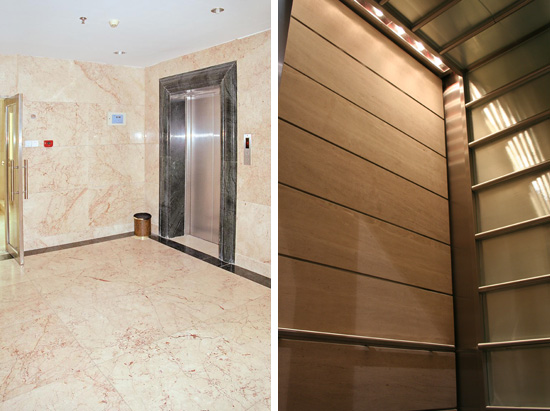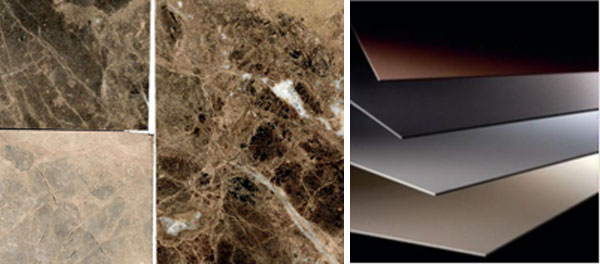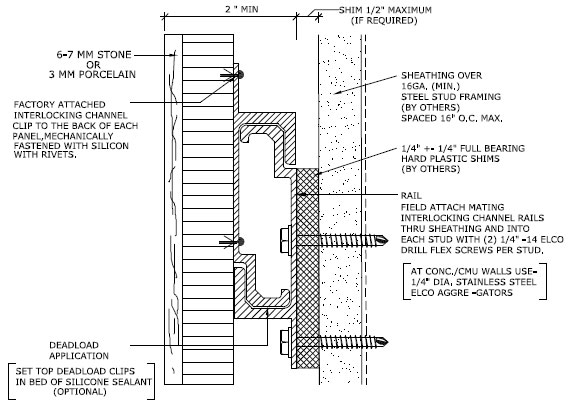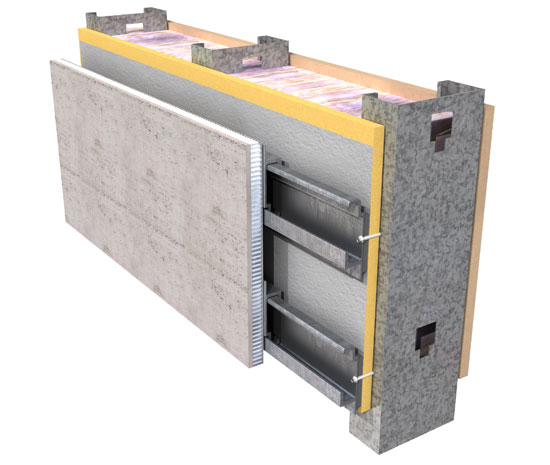Less Is More with Lightweight Honeycomb Reinforced Stone and Porcelain Panels
The Materials and Resources category under LEED v. 4 takes a rather different approach to defining the green nature of building products. There are still credits for Building Re-use and Construction Waste Management, but the rest of the approach focuses on the full life cycle of those products. The key documentation needed to demonstrate performance under this approach is referred to as an Environmental Product Declaration (EPD). Individual manufacturers or a trade association can prepare specific or generic EPDs for products. The overall intent is to address an emphasis on transparency in the sourcing, ingredient, and manufacturing processes as called for in LEED v. 4. As we have seen, lightweight reinforced panels can be shown to produce more favorable environmental impacts as assessed throughout the product’s life cycle, including raw material extraction, transportation, manufacturing packaging, use, and disposal at the end of a building’s useful life.

Photos courtesy of TerraCORE Panels, LLC
Lightweight stone panels can be shown to have favorable life cycle results as demonstrated in Environmental Product Declarations (EPDs) and preferable indoor environmental performance as shown in Health Product Declarations (HPDs).
One of the numerous methods to track the environmental benefits of a product is a program called GreenWizard which is a new software system that allows users to manage the selection of green materials and the workflow for green rating systems. This includes tracking materials and their application to LEED® credits. Materials in the searchable database are collected from manufacturers who provide product data, supplier information, and documentation that enables product transparency when comparing materials for green attributes. Individuals who want to search the database for information on a product can do so by subscribing to a free registration. GreenWizard is also a repository for EDPs as well as Health Product Declarations (HPDs). The Health Product Declaration Collaborative created and supports the HPDs as an impartial tool for the accurate reporting of product contents and each ingredient’s relationship to the bigger picture of human and ecological health. The HPD objectively defines the critical information needed to support accurate supply chain disclosure by manufacturers and suppliers, and informed decisions by building designers, specifiers, owners, and users.
Specifying Lightweight Honeycomb Reinforced Stone Wall Panels
When specifying lightweight reinforced wall panels, there are choices and specification details to pay attention to. Coordination with manufacturers during the design phases of a project will help gain insight into details, cost drivers, installation requirements, and fabrication lead times. Some of the relevant items to address in a standard 3-part specification format are highlighted as follows.
Part 1 - General
Quality assurance is often addressed by citing specific national testing and standards for products. In the case of lightweight reinforced wall panels, there are three that are particularly relevant:
• ASTM C880 - Standard Test Method for Flexural Strength of Dimension Stone. This will be relevant to any stone products selected or specified.
• ASTM B221 - Standard Specification for Aluminum-Alloy Extruded Bars, Rods, Wires, Shapes and Tubes. This test will be relevant to the aluminum honeycomb backing when used on a reinforced panel.
• ASTM D897 - Standard Test Method for Tensile Properties of Adhesive Bonds which will apply to epoxy or other adhesives used in the fabrication of the panels.
Beyond that, exterior panels should be tested for all of the usual things expected in an exterior cladding system such as air leakage, structural performance, water penetration, and wind resistance. Interior panels should be tested for surface burning characteristics and rated accordingly.
Other general specification information includes the appropriate request for submittals and shop drawings that confirm that the correct wall panels are being ordered and fabricated. It is also reasonable to request experienced installers be used with a minimum of 3 years relevant experience and approval by the panel manufacturer. Further a full warranty should be called for and submitted that demonstrates coverage for at least a 10-year coverage against delamination and separation of panel components.
Part 2 - Products
Identifying the specific lightweight reinforced wall panel products that are desired requires covering several items. If multiple product types are selected for a building, then obviously they each need to be specified and their locations identified on the drawings.
• Panel type, thickness, and size: The particular type of panel needs to be selected such as natural stone or porcelain bonded to a particular type of reinforcing or core. The thicknesses of the exposed surface needs to be called out as does the thickness of the honeycomb core, other intermediate backing sheets, and the overall thickness of the fabricated panel. Sizes of the panels are generally shown on the drawings, but parameters for minimum and maximum sizes can be addressed in the specifications.
• Stone type and finish: Fundamental to the panel appearance is the choice of stone or porcelain being used. The choice should be influenced based on interior or exterior usage and the overall design properties being sought. The specific finish of the stone should also be called out from available options of polished, honed, flamed, antiqued, sandblasted, acid washed, or bush-hammered.

Photo courtesy of TerraCORE Panels, LLC
The particular type, thickness, and finish of stone (shown on left) or porcelain (on right) needs to be specified for individual design projects as selected from a range of choices.
• Aluminum honeycomb: The type of aluminum alloy and information related to the aluminum portions of the panel should be identified. The size of the cell and the thickness of the cell walls, along with the top and bottom details can also be specified based on manufacturing options. Note that the inherent strength of the honeycomb is based on the thickness and configuration of the aluminum.
• Adhesives – Epoxy is the common adhesive to bond the facing panel to the honeycomb core. All adhesives must meet code and testing requirements.
• Attachments: Concealed fastening is most often used and will thus dictate the specific attachment methods consistent with the manufacturer’s system. As such, it should be specified to be provided by the same company that provides the panels as a complete, integrated system.
• Accessories: Fasteners and joint sealers may be recommended by the manufacturer but need to be addressed to be sure they are appropriately suited to the particular building application.
• Fabrication: Details of fabrication such as system installation, joint details, and sealer application (or not) should all be called out as appropriate.
Since some aspects of products vary between manufacturers, using the specification items above will aid in product-to-product comparisons during design and assure appropriate installations during construction.
Part 3 - Execution
Installing pre-fabricated wall panels is fairly straightforward but requires appropriate attention to detail to assure the desired outcome is achieved. It is important to note that stone is a natural material with part of its beauty and appeal coming from variations and irregularities in the surface and appearance. Everyone involved should expect this variation within the normal range of tolerances for any given stone type.
• Examination and Preparation: The rest of the exterior wall assembly needs to be in place with the requisite air and water barrier already installed. This should all be inspected for completeness and conformance with the building design and adequacy for correct attachments before the wall panels are installed.
• Installation and Field Quality Control: Since it is the installation of the fastening system that can determine if the panels end up appropriately aligned, level, and plumb, special attention should be paid to aligning clips or channels properly. Installers should definitely follow manufacturers’ instructions and approved shop drawings and comply with allowable tolerances.

Image courtesy of TerraCORE Panels, LLC

Photo courtesy of TerraCORE Panels, LLC
Installation systems for panels may vary and should be coordinated with manufacturers to be sure that field quality control is maintained.
• Repairs: As a natural material, it is not uncommon for chips or gouges to occur either in shipping or installation. Small chips, scratches, etc. can usually be smoothed out with a diamond file, buffer, or sandpaper. For large areas, a two-part non-yellowing stone epoxy can be mixed with a bit of tint to match and a little stone dust from a scrap panel. Apply into the damaged area and clean and smooth with a putty knife. If the stone has natural markings, a permanent marker can add in a little accenting to prevent the repair from standing out. This procedure normally makes repairs virtually invisible.
• Joint sealer: Where joint sealer is used or required, it should be specified in the appropriate specification section consistent with good sealing practices, code compliance, and manufacturers’ recommendations.
• Cleaning and Protection: The nature of most panel finishes is to be fairly smooth and easy to clean. In most cases, dust and dirt from construction can be easily wiped clean with a soft cloth or rinsed with water.









